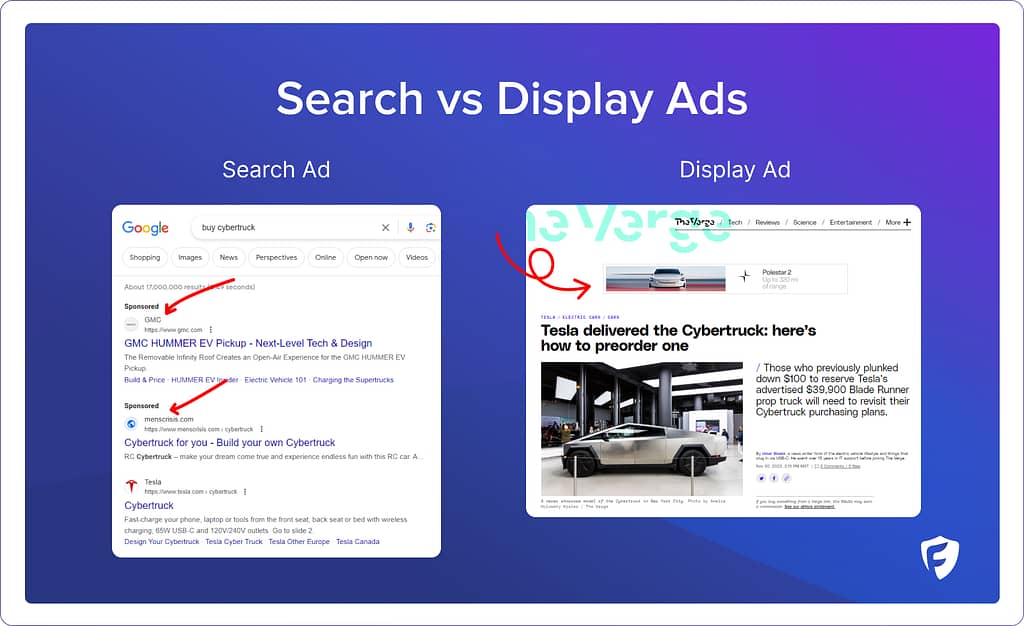What is Google Display Network (GDN)?
Google’s Display Network allows you to buy ads across the entire internet. They are typically the large “banner” ads you see on most websites, but today that can be text ads, videos and more.
GDN’s reach is unparalleled, and serves ads to a staggering 90% of internet users globally. Utilizing GDN effectively can significantly enhance your brand’s visibility and engagement, making it an important component in digital marketing strategies.
How does the Google Display Network work?
At the core of GDN’s functionality is its ability to display your advertisements across a vast network of websites. This is achieved through a combination of targeting options and remarketing strategies. These include:
Keyword Targeting: Selecting relevant keywords to match your ads with similar content across the web.
Placement Targeting: Handpicking specific websites or placements where you want your ads to appear.
Topic Targeting: Choosing from a list of topics to find relevant websites where your ads can be displayed.
Interest-based Targeting: Targeting users based on their online interests and browsing behavior.
Demographic Targeting: Reaching a specific audience based on age, gender, parental status, or household income.
Remarketing: a powerful feature of GDN, remarketing allows you to target visitors who have previously interacted with your site. This method significantly increases the chances of conversion by reminding these potential customers of their interest in your products or services.
What’s the difference between Google’s search and display network?
Google’s Search Network places your ads in front of users that are actively searching on Google based on specific keywords such as “buy Xbox Series X”, while Google’s Display Network places your ads on websites based on interests and browsing behaviors, such as video game news websites.
Bidding options on Google Display Network
GDN offers a lot of bidding options depending on your business goals. Automated bid strategies like CPA (Cost Per Acquisition) and ROAS (Return On Ad Spend) help in optimizing the bids for conversions or value, making sure that you get the most out of your budget.
Here are the bidding options on Google Display Network:
- Manual Cost-Per-Click (CPC)
- Enhanced Cost-Per-Click (eCPC)
- Cost-Per-Thousand (CPM) – Also known as “Viewable” CPM
- Target CPA
- Maximize Conversions
- Maximize Conversion Value
- Target Return on Ad Spend (tROAS)
- Maximize Clicks
You can learn more about these and other bid strategies in Google Ads.
5 Strategies to outperform on Google Display Network
- Avoid Made-For-Advertising (MFA) Websites: Some sites are solely designed to get readers to click or view as many ads as possible on their page. These websites are known as “Made-For-Advertising” and typically provide clickbait, sensational headlines and provocative imagery with low-quality content and an extremely large (almost abusive) amount of ad banners on page. Excluding these from your ad campaigns can help boost your performance.
Here’s our list of 284 MFA sites you can exclude today. - Use Stunning Images: Visual appeal can make or break your ad’s performance. Ensure your images are clear, relevant, and attractive. This may seem obvious, but boring hurts performance.
- Use Negative Keywords: Negative keywords are words that you add to your display campaigns so that your ads won’t appear on websites where it has content that contains that word. For example, if you want to target users that play Xbox games, you may want to add the negative keyword of “playstation” to avoid appearing on pages with content on PlayStation games. Here’s our recommended list of negative keywords you can use for your display (or search) campaigns today.
- Optimize Landing Pages: A high-quality landing page is more critical than ever for success. Ensure your landers have a crystal clear headline with a strong call-to-action. They also need to be mobile-friendly and provide a seamless experience throughout.
- Avoid Invalid Clicks: Google Display Network can unfortunately have poor quality traffic that comes from bots, domain spoofing, ad stacking and other forms of ad fraud. While Google also monitors for fraud, consider using an independent ad fraud prevention platform such as Fraud Blocker that go above-and-beyond what Google catches.
Frequently asked questions
What are the common mistakes to avoid in GDN advertising?
Because of GDN’s large reach, it’s easy to overspend if you do not optimize your campaigns. Some mistakes are: neglecting to refine target audiences, using low-quality visuals, underutilizing or not testing ad variations and formats, and not optimizing ads based on performance data. It’s also important to double-check your location targeting settings so Google doesn’t show ads outside your target location.
Does Google Display Network contain any ad fraud?
GDN is a great (and cheap) way for advertisers to reach a broad audience, but that vast reach can have a cost: despite Google’s best efforts, there are fraudulent websites that serve no other purpose than to make money through serving ads. These are often bots and click farms the website publishers use to increase their gains. If your ad lands on their site, you might as well save the time and hand them your cash.
Are there best practices for targeting on GDN?
Targeting on GDN should be a balance between reaching a broad audience and maintaining relevance, all while keeping your key performance metrics in mind (CPA, CPL, ROAS, etc.). Utilize a combination of demographic, interest-based, and contextual targeting to align your ads with the most appropriate audience. But be careful, GDN is a very large network and you can quickly spend your budget if you don’t target correctly.
Related glossary terms:





